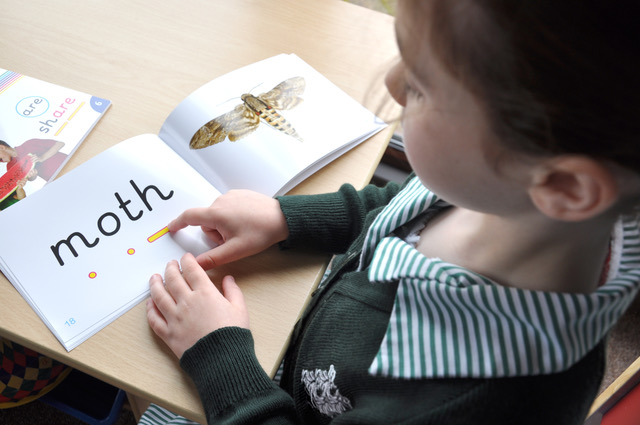No products in the cart.
Let’s Read Series: The Fun and Easy Way to Learn Reading
July 3, 2018

Two of the key skills required for learning to phonetically read are phoneme recognition and blending. Children who struggle with these early reading skills are likely to fall behind in literacy. There is a shortage in resources that are specifically designed to support children with diverse learning needs. To address this, WordUnited has created the “Let’s Read” series: eight levelled books designed by teachers that cover nearly all the sounds of English and teach blending using a unique method.
One of the striking features of the “Let’s Read” series is the books burst with real-life and vivid images that help keep young learners engaged. Yet, all books adopt a refreshingly minimalist design that includes only the content required for learning. This design is intended to help easily distracted children maintain focus. Furthermore, the text is over-sized and colour-coded, and uses an easy-to-read child-friendly font. These high-quality books with glossy covers are manufactured using durable paper with high clarity. They are A5 sized with a portrait orientation, making them perfect for one-to-one and small group work. It is recommended that the books are used to supplement other learning approaches and 10 to 15 sessions are ideal to introduce a new sound or to recap learning. Teaching guidance is included.
The series starts with the first title: “Simple Phonics”. This book introduces all the consonant sounds, including consonant digraphs, as well as the five simple vowels: a, e, i, o and u. The first half of the book lists the “bouncy” sounds. These are short sounds that you “bounce” off when you repeat saying them such as “b-b-b” and “k-k-k”. The second half lists the “stretchy” sounds, which are continuous sounds that can be “stretched” such as “mmm” and “rrr”. Phonemes that have the same sound are grouped together, such as “c”, “k” and “ck”. There are example words for each sound and each phoneme is colour-coded in bright pink in example words.
Following the introduction of simple phonemes, blending is introduced in the following two books: “Step-by-Step Mini Words” and “Step-by-Step Bigger Words”. Here, blending is gently and intuitively explained using a unique method that has never been published before. Sometimes teachers cover parts of a word when introducing blending, especially for children attempting to blend for the first time, or for children struggling to blend. WordUnited has developed a simple yet innovative approach where the first page contains only the first letter and the opposite page shows a partial image. Gradually, the following pages add more letters, step-by-step, and the complete image is revealed as children read a full word. The two books that introduce blending cover all the five simple vowels. The “Mini Words” books includes only CVC words with single-letter consonants, such as “cat”, while the “Bigger Words” book includes words with consonant digraphs, such as “moth”. Each phoneme has a prompt underneath it to encourage children to point at the sound and concentrate.
As children master blending, more complex sounds are gradually introduced. The fourth and fifth books, “Double-Letter Phonics” and “More Double-Letter Phonics”, introduce vowel digraphs, such as “ee”. Where two digraphs share the same sound, for example “ee” and “ea”, they are placed in hexagons having identical colour. These books include many examples to reinforce recognising the sounds and reading words containing vowel digraphs. The sixth book, “Advanced Phonics”, introduces trigraphs and even more complex sounds such as “igh” and “tion”. By the sixth book, children can read words as advanced as “precious” and “scrumptious”.
The seventh book, “Split Digraphs”, helps children to step-by-step learn the five split digraphs: “a-e”, “e-e”, “i-e”, “o-e” and “u-e”. Arcs over the split digraphs prompt children to recognise their sounds in words.
The eighth and final book in the “Let’s Read” series is “Silent Letters”. It helps children recognise silent letters that are not pronounced in certain words, such as “t” in “listen”. For each letter, a group of words in which that letter is not pronounced is listed. The silent letters are colour-coded in grey and, unlike the other letters, they lack prompts underneath.
All the words throughout this series are carefully selected so they are child-friendly, relevant, interesting and easy to sound out. The accompanied images representing the words encourage children to read while providing “clues” to the words. However, plenty of revision pages and practice words without pictures are included to assess learning.
The “Let’s Read” series is a “one stop” learning resource that covers all the English sounds taught at EYFS and KS1 and teaches blending and reading in a unique way. The books are highly recommended for easily-distracted children and for children struggling with early reading.
Available to buy as single books (£5.99 each) or as a complete set (£37.99) from www.wordunited.com.
Let’s Read – Simple Phonics ISBN: 9781911333241
Let’s Read – Step-by-Step Mini Words ISBN: 9781911333258
Let’s Read – Step-by-Step Bigger Words ISBN: 9781911333265
Let’s Read – Double-Letter Phonics ISBN: 9781911333272
Let’s Read – More Double-Letter Phonics ISBN: 9781911333289
Let’s Read – Advanced Phonics ISBN: 9781911333296
Let’s Read – Split Digraphs ISBN: 9781911333302
Let’s Read – Silent Letters ISBN: 9781911333319



 01782 698558
01782 698558

